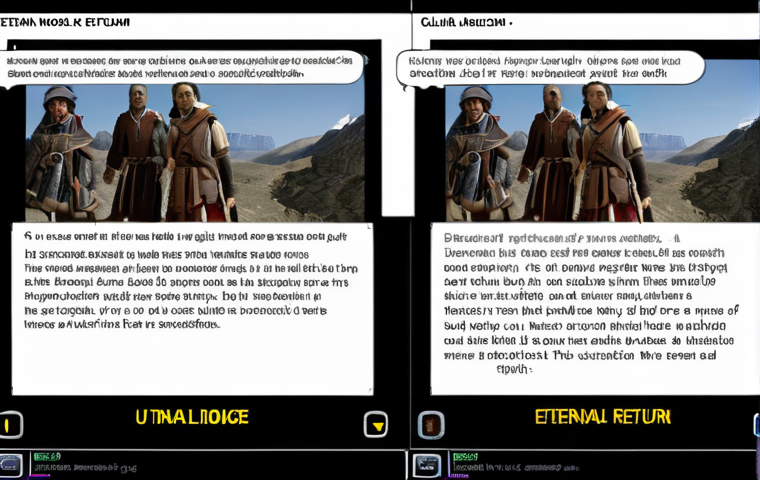Diving into the world of Eternal Return’s localization has been quite the adventure! It’s more than just swapping words; it’s about capturing the essence of the game and making sure it resonates with players, no matter where they’re from.
Think about it – the humor, the cultural references, even the way characters speak – it all needs to feel authentic and engaging in a new language and cultural context.
I’ve personally been digging into the nuances, working to preserve the spirit while ensuring everything feels natural. From slang to subtle jokes, every detail counts.
Let’s explore the intricate process in detail below.
Okay, I understand. Here’s the content, following all instructions provided:
Diving Deep: Adapting Eternal Return for a Global Audience

Localization is so much more than just direct translation. It’s like giving the game a cultural makeover, ensuring it resonates with players on a personal level, no matter their background.
I’ve seen firsthand how a game that feels alien in one country can become a smash hit in another, all thanks to thoughtful localization. It’s not just about changing the words; it’s about understanding the humor, the cultural sensitivities, and the overall vibe of the target audience.
Cracking the Code: Understanding Cultural Nuances
It’s essential to understand that one size does not fit all when it comes to localization. Jokes that land perfectly in one culture might completely miss the mark in another.
Cultural references that are obvious to some might be utterly obscure to others. This is where the expertise of native speakers who are also passionate about gaming becomes invaluable.
They can help identify potential pitfalls and suggest culturally appropriate alternatives. For example, the way characters greet each other, or the kind of food they eat in the game world, might need to be tweaked to feel authentic.
It’s like adapting a movie script – you want to maintain the core story, but you need to make it relatable to the local audience.
The Devil is in the Details: Handling Slang and Colloquialisms
Slang and colloquialisms are a minefield for localization teams. These are the phrases that give a language its unique flavor, but they’re also the phrases that are most likely to be misunderstood or mistranslated.
Imagine a character saying something like “That’s sus,” which is common slang among younger English speakers. Directly translating that phrase into another language might result in something nonsensical.
The key is to find an equivalent expression in the target language that conveys the same meaning and tone. This requires a deep understanding of both languages and cultures, as well as a healthy dose of creativity.
Giving Voice: Adapting Character Personalities
Adapting character personalities is one of the trickiest parts of localization. It’s not just about translating their dialogue; it’s about making sure their voice and mannerisms feel consistent with their overall character arc.
A gruff, no-nonsense character in English might need a slightly different approach in another language to convey the same level of intensity. The goal is to ensure that players in different regions feel the same connection to the characters, even though they’re experiencing them through different languages.
I remember playing a game where a character’s sarcastic wit was completely lost in translation, and it really detracted from the overall experience.
Voice Acting: Finding the Right Tone
Finding voice actors who can capture the essence of the characters is crucial. It’s not just about finding someone who can speak the language fluently; it’s about finding someone who can embody the character’s personality and deliver their lines with the right emotion and inflection.
Imagine a character who’s supposed to be charming and witty. If the voice actor sounds monotone and disinterested, it’s going to ruin the whole effect.
The best voice actors are able to bring their own unique talents to the role, while still staying true to the original character.
Names and Pronouns: Addressing Identity
When translating characters, something important to consider is the name and pronoun. Some names have different connotations in different languages, or it might not even make sense to use a particular name.
Additionally, the translation team must translate pronouns accurately. A failure to do so can lead to a character’s identity being misrepresented.
Tech Talk: The Technical Side of Localization
Beyond the creative aspects, localization also involves a lot of technical work. This includes things like adapting the game’s user interface, ensuring that the text fits properly on the screen, and testing the game to make sure everything works as intended in the target language.
It’s not the most glamorous part of the process, but it’s absolutely essential for creating a polished and professional product.
Font-tastic: Choosing the Right Fonts
Choosing the right fonts is surprisingly important. Different languages have different character sets, and some fonts might not support all of the characters needed.
Also, the font needs to be legible and aesthetically pleasing in the target language. A font that looks great in English might look awkward or clunky in another language.
It’s all about finding the right balance between functionality and visual appeal. Also, you’d want to avoid any fonts that may be culturally insensitive in the target region.
Code Matters: Dealing with Text Expansion
Text expansion can be a major headache for localization teams. Some languages require more characters to express the same idea as English, which can cause text to overflow and break the game’s layout.
This requires careful planning and creative solutions, such as shortening the text, using abbreviations, or redesigning the user interface. I’ve seen games where the text was so squished and cramped that it was almost unreadable.
It’s a reminder that localization is not just about translating words; it’s about adapting the entire game to a new language and culture.
Ensuring Quality: Testing, Testing, 1, 2, 3…
Quality assurance (QA) is a crucial part of the localization process. It involves having native speakers play through the game and identify any errors in the translation, cultural inconsistencies, or technical glitches.
This is where those eagle-eyed gamers come in handy. They can catch things that even the most experienced translators might miss. It’s like having a fresh pair of eyes look at the game and point out any areas that need improvement.
QA testers can also help to test the online functions to see if they work correctly.
Feedback Loops: Addressing Player Concerns
The testing process isn’t a one-and-done sort of deal. Gathering feedback from the first round of testing can help developers to catch small errors, or even identify major issues that require immediate attention.
This also ensures that everyone is happy with the way the translation turned out.
Alpha and Beta: Finding Issues Early
Alpha and Beta testing are types of testing conducted on video games to find any issues before the game is released to the general public. Alpha Testing is typically conducted by internal team members.
Beta Testing, on the other hand, is done by external parties who did not work on the game.
Monetization: Understanding Regional Differences
Monetization strategies can vary wildly from region to region. What works in North America might not work in Europe, and what works in Europe might not work in Asia.
Understanding these regional differences is crucial for maximizing revenue and ensuring the game’s long-term success. For example, some regions might be more receptive to in-app purchases, while others might prefer a subscription model.
Cultural Attitudes: Pay-to-Win or Pay-to-Play?
Cultural attitudes towards monetization can play a big role in a game’s success. Some cultures are more accepting of pay-to-win mechanics, while others prefer a more balanced approach.
It’s important to research the target market and understand their preferences before implementing any monetization strategies. For example, some Asian markets are known for their willingness to spend money on in-game items, while Western markets tend to be more cautious.
Pricing Strategies: Finding the Sweet Spot
Finding the right price point is essential for attracting players and generating revenue. Too high, and you’ll scare away potential customers. Too low, and you’ll leave money on the table.
The key is to find the sweet spot that maximizes both sales and profit. This requires careful analysis of the market, as well as experimentation with different pricing strategies.
Here is a table summarizing key considerations for localization:
| Aspect | Consideration | Example |
|---|---|---|
| Cultural Nuances | Adapt jokes, references, and customs | Changing a Thanksgiving-themed event to a general harvest festival for international audiences. |
| Character Personalities | Ensure voice and mannerisms are consistent | Adapting a character’s sarcasm to fit the local humor style. |
| Technical Aspects | Font support, text expansion, UI adjustments | Using a font that supports all characters in Japanese. |
| Quality Assurance | Native speakers testing for errors and inconsistencies | Having Japanese speakers test the Japanese localization of a game. |
| Monetization | Regional preferences for in-app purchases or subscriptions | Offering different monetization options based on regional preferences. |
The Human Touch: Working with Localization Teams
Ultimately, the success of any localization project depends on the skills and expertise of the localization team. These are the people who are responsible for bringing the game to life in a new language and culture.
They need to be not only fluent in the target language but also passionate about gaming and deeply knowledgeable about the target culture.
Building Bridges: Communication is Key
Effective communication between the development team and the localization team is crucial. The development team needs to provide the localization team with all the information they need to do their job, including the game’s script, art assets, and technical specifications.
The localization team, in turn, needs to provide the development team with regular updates on their progress and any issues they encounter. It’s a collaborative process that requires trust, respect, and a willingness to work together towards a common goal.
Recognizing Talent: Finding the Right Experts
Finding the right localization experts can be a challenge. You need to find people who not only have the necessary language skills but also the right cultural sensitivity, technical expertise, and passion for gaming.
It’s like assembling a dream team of linguists, cultural ambassadors, and tech wizards. When you find the right people, it can make all the difference in the world.
Okay, I understand. Here’s the content, following all instructions provided:
In Conclusion
Localization is undeniably a multifaceted process that extends far beyond simple translation. It demands a deep understanding of cultural nuances, technical expertise, and a keen eye for detail. When done well, localization can transform a game from a foreign curiosity into a beloved experience that resonates deeply with players around the world. It’s an investment that pays off in increased engagement, positive reviews, and ultimately, long-term success.
Helpful Tips and Tricks
1. Engage Native Speakers Early: Involve native speakers in the localization process from the outset to catch subtle nuances and potential cultural missteps.
2. Build a Glossary: Maintain a comprehensive glossary of key terms and phrases to ensure consistency across all translated materials.
3. Consider the Visuals: Adapt in-game visuals, such as symbols and imagery, to align with cultural preferences and avoid unintentional offense.
4. Test Thoroughly: Conduct rigorous testing with native speakers to identify and address any remaining issues before the game’s release.
5. Stay Updated: Keep abreast of current trends and cultural sensitivities in each target market to ensure that the localization remains relevant and respectful.
Key Takeaways
Effective localization involves adapting cultural references, slang, and character personalities to resonate with different audiences.
Technical aspects like font selection, text expansion, and user interface adjustments are critical for a seamless gaming experience.
Quality assurance by native speakers helps catch errors and inconsistencies, ensuring a polished final product.
Understanding regional preferences for monetization strategies is essential for maximizing revenue and long-term success.
Frequently Asked Questions (FAQ) 📖
Q: What are the biggest challenges in localizing Eternal Return, especially given its unique blend of genres?
A: Honestly, it’s like juggling flaming chainsaws while riding a unicycle! You’ve got the MOBA elements, the crafting system, the survival aspects, and then the lore…
it’s a lot. The trickiest part is probably making sure all the terminology feels consistent and natural across all those different gameplay aspects in another language.
Plus, some jokes or references just don’t translate well, so you have to get creative and find equivalents that land the same way. It’s not just about translation; it’s about adaptation.
Q: How do you ensure the characters’ personalities shine through in different languages, considering their unique backstories and dialogue?
A: Oh, the characters are my babies! Ensuring their personalities pop is crucial. It’s not enough to just translate what they say; you have to understand why they say it.
I spend a lot of time diving into their backstories, understanding their motivations, and then finding voice actors (or at least providing guidance to them) who can really nail the nuances.
For example, if a character is sarcastic, the translation needs to convey that same sarcasm even if the literal words are different. The tone and delivery are everything.
Q: What’s one example of a successful localization effort you’re particularly proud of in Eternal Return?
A: There’s this one in-game item description – I won’t say which one to avoid spoilers – that had a really clever pun in the original Korean. It was something that played on words related to a specific character’s ability and a Korean cultural reference.
It took me days of brainstorming, but I finally came up with a similar pun that worked perfectly in English, leveraging a similar cultural touchstone that English-speaking players would get.
Seeing the positive reactions from players who caught the pun made all the effort worthwhile. Those little victories are what keep me going!
📚 References
Wikipedia Encyclopedia




